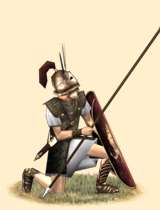Triarii (Polybian Heavy-Spear Maniple)
 |
Weapons | Defence | Mental | ||||||
|---|---|---|---|---|---|---|---|---|---|
| Primary | Secondary | Armour: | 12 | Morale: | 15 | ||||
| Type: | spear | none | Shield: | 4 | Discipline: | disciplined | |||
| Attack: | 15 | 0 | Skill: | 9 | Training: | highly_trained | |||
| Charge: | 4 | 0 | Recruitment | Other | |||||
| Lethality: | 0.13 | 0.1 | Soldiers: | 40 | Hit Points: | 1 | |||
| Range: | 0 | 0 | Cost: | 1524 | Mass: | 1.2 | |||
| Ammo: | 0 | 0 | Upkeep: | 381 | |||||
| Turns: | 1 | ||||||||

The triarii are the oldest but also most experienced soldiers of a legion and forming the third line. They fight with long hasta spears in a close formation more suited to stop the enemy and stabilize the line if all hope rest on them.
They can be recruited all Italian homeland provinces, the central heartlands of the Res Publica as well as the recently colonised areas in the south and the Po valley.
The 600 Triarii are the oldest and most experienced soldiers of the legion, forming its last reserve, the third line. Most often during battle they rest in reserve on one knee, under cover of their shields, to stay fresh and protected until they are needed. They are the rock of the legion, covering a "rearward advance" if the heavy infantry assault fails, and an old Roman adage came of their use: "to have come to the Triarii" meant that the situation was dire, indeed.
Armed with a hasta thrusting spear and a gladius, Triarii are protected by a scutum, a bronze Montefortino helmet, a bronze greave on the leading leg and now mostly by a coat of lorica hamata (chain mail). They continue to fight with long hasta spears in a close formation more suited to stop the enemy and stabilize the line if all hope rest on them.
.The high quality equipment has become one of the great strengths of the Roman infantry, besides their strict discipline. The scutum is an oval, canvas covered, plywood shield, around 1.2m high, that offers excellent protection against most weapons. The gladius hispaniensis, adapted during the late 3rd century BC conflicts, is a great weapon for fighting in close formations. Its strong, unbending blade has a sharp point to penetrate heavy armour and can deal an effective blow with both edges. So it can be used for stabbing or slashing as well. The pilum, the heavy Roman javelin, is designed to bend after impact so that it is worthless for the enemy and is difficult to remove from shields. Its weight also gives the weapon great penetration capability.
Historically, the Triarii were also divided into ten maniples, but each was half the size of those containing Hastati or Principes. Normally, the legion advanced in the famous, chessboard like, quinqunx formation. Three lines of heavy infantry with broad gaps between the single manipuli covered by the next line's displaced marching units. This practice gave the Roman army a higher maneuverability on the battlefield and made it less dependant upon the terrain than the Greek phalanx. During the battle the gaps allowed beaten or retreating units as well as fresh troops to move through the lines.
Over many centuries the Romans had the reputation to be more willing than others to adopt new customs and techniques if they proved useful. This was seen as one of their greatest strengths. The Montefortino Helmet was probably of Celtic origin and was adapted during the 3rd Century BC conflicts.
Every male roman had the duty to serve in the infantry for 16 years, or 20 years in the case of national emergency, until he had completed his 46th year of life. Excepting those rated high enough by the censor to be members of the ordo equester or those rated with less than 400 drachmae worth of property, who have to serve in the fleet. Normally every roman must have served at least ten years in the military before he was permitted to hold any political office.